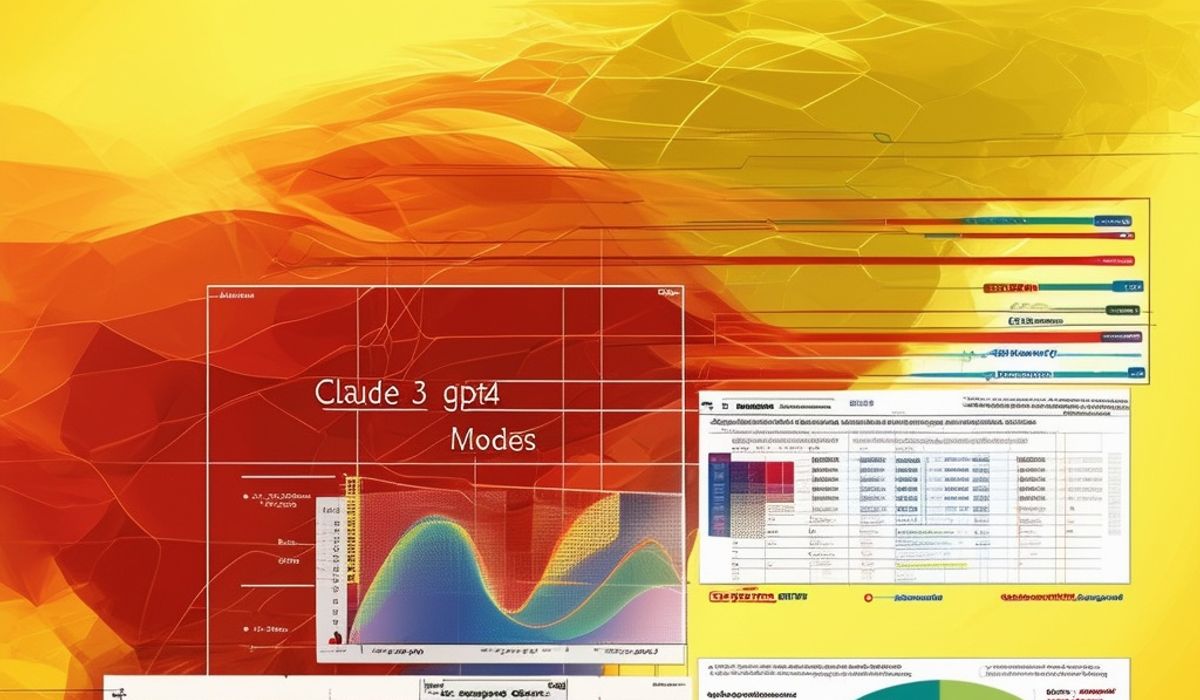Are you ready to dive into the thrilling world of AI language models? Brace yourself for a captivating showdown between two titans: Anthropic’s Claude 3 and OpenAI’s GPT-4. These cutting-edge models are reshaping the landscape of natural language processing, and the stakes have never been higher. Get ready to witness a clash of computational titans as we dissect their strengths, weaknesses, and potential impact on the future of AI.
Key Takeaways | Claude 3 | GPT-4 |
Largest Model Size | Opus (200k token context window) | 128k token context window |
Benchmark Performance | Outperforms on many benchmarks like MMLU, GSM8K, and TruthfulQA | Competitive performance, sometimes exceeds Claude 3 on certain benchmarks like LiveCodeBench |
Coding/Programming | Excels at coding tasks, provides focused and actionable responses | Good at coding, but limited output size can be inconvenient |
Logical Reasoning | Slightly behind GPT-4 on advanced logical reasoning tasks | Slightly ahead of Claude 3 on advanced logical reasoning tasks |
Internet Access | No direct internet access | Can access the internet for real-time data with ChatGPT |
Pricing | Lower cost per token | Higher cost per token |
Table of Contents
Introduction to Claude 3 and GPT-4

Overview of Claude 3
Introduced by Anthropic, Claude 3 is a family of large language models that have taken the AI world by storm. This series includes three distinct models: Opus, Sonnet, and Haiku, each designed to cater to specific tasks and requirements.
Key Features and Capabilities of Claude 3
Opus: The flagship model, boasting a staggering 200k token context window, making it ideal for handling large-scale tasks and processing extensive amounts of information.
Sonnet: A versatile mid-tier model, well-suited for complex tasks such as product recommendations, code generation, and creative writing.
Haiku: The compact and speedy entry-level model, perfect for automating basic tasks and streamlining daily workflows.
Claude 3 models are accessible through various channels, including Anthropic’s web interface, USUnlocked, and Context AI. Additionally, users can experience the models through platforms like TextCortex, which unlock their full potential with advanced retrieval and generation capabilities.
Context Window and Output Size
One of the standout features of Claude 3 Opus is its remarkable 200k token context window, dwarfing the 128k token limit of GPT-4. This expansive context window allows Opus to process and retain a substantial amount of information, making it well-suited for tasks that require extensive context and long-form content handling.
Overview of GPT-4
Developed by OpenAI, GPT-4 is an advanced large language model that has captivated users with its versatility and capabilities. Known for its ability to analyze text, code, visual, and audio inputs, GPT-4 generates human-like responses by leveraging its trained data, web search feature, and robust parameters.
Key Features and Capabilities of GPT-4
Multimodal Functionality: GPT-4 can process and generate output based on a wide range of inputs, including text, code, images, and audio, making it a powerful tool for tasks like document analysis and content creation.
Web Access: With its ability to access the internet, GPT-4 can provide real-time data and up-to-date information, enhancing its responses and ensuring greater accuracy.
Language Support: GPT-4 supports over 25 languages, allowing users to communicate and generate content in multiple languages with ease.
Multimodal Functionality
One of GPT-4’s standout features is its multimodal functionality, enabling it to analyze and generate output based on various input types, including text, code, images, and audio. This versatility makes GPT-4 a powerful tool for tasks like document analysis, content creation, and data interpretation.
Importance of Comparing Language Models
In the rapidly evolving landscape of AI, comparing language models is crucial for understanding their strengths, weaknesses, and suitability for specific tasks. As organizations and individuals increasingly rely on AI for critical decision-making and problem-solving, choosing the right language model can have a profound impact on efficiency, accuracy, and overall success. By conducting comprehensive comparisons, we can make informed decisions and leverage the full potential of these powerful tools.
Performance Benchmarks: Claude 3 vs GPT-4

Standard Benchmark Comparisons
Benchmarks provide a standardized way to evaluate and compare the performance of language models across various tasks and datasets. According to Anthropic’s technical report, the Claude 3 models, particularly Opus and Sonnet, have set new standards in performance, outperforming GPT-4 on several widely recognized benchmarks.
MMLU Performance
On the MMLU (Multitask Multitask Benchmark) benchmark, which measures a model’s ability to handle a diverse range of natural language understanding tasks, Claude 3 Opus achieved a remarkable score of 66.5%, surpassing GPT-4’s score of 60.7%.
TruthfulQA Results
The TruthfulQA benchmark evaluates a model’s ability to provide truthful and accurate responses. Here, Claude 3 Opus demonstrated its prowess, scoring 69.9%, while GPT-4 trailed slightly behind with a score of 67.4%.
While these benchmarks provide valuable insights, it’s important to note that results can vary based on factors such as prompt engineering, fine-tuning techniques, and the specific tasks or datasets being evaluated. Additionally, user reports and independent evaluations have also highlighted instances where GPT-4 outperforms Claude 3 on certain tasks or benchmarks.
Task-Specific Performance Analysis
Beyond standard benchmarks, it’s crucial to evaluate language models on specific tasks and use cases to determine their suitability for your needs. In this section, we’ll compare Claude 3 and GPT-4 across various tasks, drawing insights from user experiences, industry reports, and our own evaluations.
Creative Writing Capabilities
When it comes to creative writing tasks such as writing stories, newsletters, or social media posts, Gemini often takes the lead, producing the most human-like and engaging content. However, Claude 3 can be configured to sound more natural than GPT-4 with minimal effort, making it a strong contender for longer writing projects.
Mathematical and Logical Reasoning
GPT-4 excels at solving complex mathematical problems and logical reasoning tasks, thanks to its ability to understand and process visual inputs like images of problem statements. However, Claude 3 is no slouch in this area, performing slightly behind GPT-4 on advanced tasks but still delivering impressive results.
Coding and Programming Proficiency
Both Claude 3 and GPT-4 are highly capable when it comes to coding and programming tasks. However, reports suggest that Claude 3 Opus outperforms GPT-4 in certain coding benchmarks, providing more focused and actionable responses.
One advantage of Claude 3 Opus is its larger context window, which can be beneficial when working with extensive codebases or documentation. Additionally, its ability to generate longer outputs in a single prompt can save time and tokens, making it a more efficient choice for certain coding tasks.
Document Summarization and Data Extraction
When it comes to summarizing documents or extracting data from PDFs, user experiences indicate that Claude 3 has a slight edge over GPT-4. Claude 3’s ability to process and retain larger contexts allows it to provide more comprehensive and accurate summaries and data extractions, particularly for longer or more complex documents.
Handling Long-Form Content
Thanks to its impressive 200k token context window, Claude 3 Opus shines when handling long-form content, such as academic papers, legal documents, or extensive reports. This capability allows Opus to process and retain a significant amount of information, making it well-suited for tasks that require extensive context and in-depth understanding.
Pricing and Accessibility
Claude 3 Pricing Models
On-Demand Pricing
Pay-as-you-go model with charges based on input tokens processed and output tokens generated.
Pricing varies depending on the model size, with Opus being the most expensive option.
Provisioned Throughput Pricing
Ability to purchase model units for guaranteed throughput, measured by the maximum number of input/output tokens processed per minute.
Hourly pricing with options for one-month or six-month terms.
Suited for large, consistent inference workloads that require guaranteed performance.
GPT-4 Pricing Models
Pay-As-You-Go Pricing
No commitment pricing model with charges based on model type and usage context.
Pricing varies by region, with GPT-4 being the most expensive option overall.
Fine-Tuning Costs
Additional charges apply for fine-tuning GPT-4 models based on training time and hosting time.
Pricing Comparison: Claude 3 vs GPT-4
Claude 3 Opus vs GPT-4 Turbo
While Claude 3 Opus surpasses GPT-4 Turbo in terms of context window size and performance on certain benchmarks, it comes at a higher cost per token. For use cases requiring a large number of output tokens, GPT-4 Turbo may be the more economical choice, despite its slightly lower performance in some areas.
Claude 3 Sonnet vs GPT-4
In terms of pricing, Claude 3 Sonnet holds a significant advantage over GPT-4. With input tokens priced 95% lower and output tokens priced 87.5% lower than GPT-4, Sonnet can be a cost-effective option for tasks where its performance is comparable to GPT-4.
Integrations and Ecosystem Support
Claude 3 Integrations
AWS Bedrock Integration
Claude 3 models are available through Amazon Bedrock, a marketplace for various AI models and providers. Bedrock offers additional APIs and security features, making it a convenient option for developers and enterprises.
Cursor Integration
Cursor, a platform for building AI applications, also supports the integration of Claude 3 models, allowing users to leverage their capabilities within their applications.
GPT-4 Integrations
Microsoft Azure OpenAI Integration
As part of a strategic partnership between Microsoft and OpenAI, Azure offers seamless integration and access to the latest OpenAI models, including GPT-4, along with additional features and security measures.
Third-Party API Integrations
GPT-4 is widely integrated into various third-party applications and platforms through APIs, allowing developers to leverage its capabilities within their products and services.
Future Outlook and Potential Developments
Anthropic’s Roadmap for Claude 3
Planned Enhancements and Updates
Continuous improvement of the Claude 3 models, with a focus on performance, accuracy, and ethical considerations.
Expansion of language support and localization efforts to cater to a global audience.
Integration with additional platforms and ecosystems to increase accessibility and adoption.
OpenAI’s Vision for GPT-4
Potential Future Iterations and Improvements
Ongoing research and development to enhance GPT-4’s capabilities, particularly in areas like multimodal processing and logical reasoning.
Exploration of new use cases and applications, such as virtual assistants, customer service chatbots, and creative AI tools.
Efforts to improve transparency, interpretability, and ethical considerations in the development and deployment of AI models.
A Captivating Conclusion: Summary of Key Findings

In this comprehensive comparison of Claude 3 and GPT-4, we’ve explored the strengths, weaknesses, and unique capabilities of these leading language models. While both models have demonstrated remarkable prowess, each excels in different areas, making the choice between them highly dependent on specific use cases and requirements.
Claude 3 Opus, with its unparalleled 200k token context window, shines in handling long-form content, document summarization, and coding tasks that require extensive context. It has consistently outperformed GPT-4 on several benchmarks, including MMLU and TruthfulQA, showcasing its natural language understanding and generation capabilities.
On the other hand, GPT-4 stands out with its multimodal functionality, allowing it to process and generate output based on various input types, including text, code, images, and audio. Its ability to access the internet also provides real-time data and up-to-date information, making it a valuable asset for tasks that require current knowledge.
While GPT-4 holds an edge in certain areas, such as advanced logical reasoning and mathematical problem-solving, Claude 3 remains a formidable competitor, often delivering more focused and actionable responses in coding and programming tasks.
Recommendations for Choosing Between Claude 3 and GPT-4

Choosing the right language model for your needs is a critical decision that can significantly impact efficiency, accuracy, and overall success. Here are some general recommendations to consider:
1. Long-Form Content and Document Handling: If your primary use case involves processing and understanding extensive documents, academic papers, or legal texts, Claude 3 Opus is the clear choice, thanks to its unmatched 200k token context window.
2. Coding and Programming: For coding tasks, Claude 3 Opus often provides more focused and actionable responses, making it a strong contender. However, GPT-4’s multimodal capabilities can be advantageous for tasks that involve processing visual or audio inputs related to code.
3. Creative Writing and Content Generation: Both models excel at creative writing tasks, but Claude 3 can be configured to produce more natural-sounding content with minimal effort, making it a suitable choice for longer writing projects.
4. Multimodal Tasks and Real-Time Data Access: If your use case requires processing various input types (text, code, images, audio) or requires access to real-time data, GPT-4’s multimodal functionality and internet access make it the preferable option.
5. Cost Considerations: For large-scale or high-volume workloads, it’s essential to consider the pricing models and overall costs associated with each language model. Claude 3 Sonnet offers a more cost-effective solution compared to GPT-4, while GPT-4 Turbo may be more economical for use cases requiring a large number of output tokens.
Ultimately, the choice between Claude 3 and GPT-4 should be guided by a thorough understanding of your specific requirements, performance needs, and budget constraints. It’s also essential to stay updated on the latest developments and advancements in the AI landscape, as these language models continue to evolve rapidly.
FAQ:
1. Which language model performs better overall, Claude 3 or GPT-4?
There is no clear winner in terms of overall performance, as both Claude 3 and GPT-4 excel in different areas. Claude 3 Opus outperforms GPT-4 on several benchmarks like MMLU and TruthfulQA, while GPT-4 has an edge in tasks involving advanced logical reasoning and mathematical problem-solving. The choice depends on the specific use case and requirements.
2. How do the pricing models for Claude 3 and GPT-4 differ?
Claude 3 offers on-demand pricing based on input/output tokens processed, as well as provisioned throughput pricing for guaranteed performance. GPT-4 follows a pay-as-you-go model with charges based on model type and usage context. Additionally, fine-tuning GPT-4 models incurs additional costs. Overall, Claude 3 Sonnet is significantly more cost-effective compared to GPT-4.
3. Can Claude 3 handle longer context windows compared to GPT-4?
Yes, Claude 3 Opus has a remarkable 200k token context window, significantly larger than GPT-4’s 128k token limit. This makes Opus well-suited for tasks that require extensive context and long-form content handling.
4. Which model is better suited for creative writing tasks?
Both Claude 3 and GPT-4 are capable of creative writing tasks, but Claude 3 can be configured to produce more natural-sounding and engaging content with minimal effort, making it a strong contender for longer writing projects.
5. Are there any notable differences in coding capabilities between Claude 3 and GPT-4?
While both models are highly proficient in coding tasks, reports suggest that Claude 3 Opus outperforms GPT-4 in certain coding benchmarks, providing more focused and actionable responses. Additionally, Opus’s larger context window can be advantageous when working with extensive codebases or documentation.






Leave a Reply